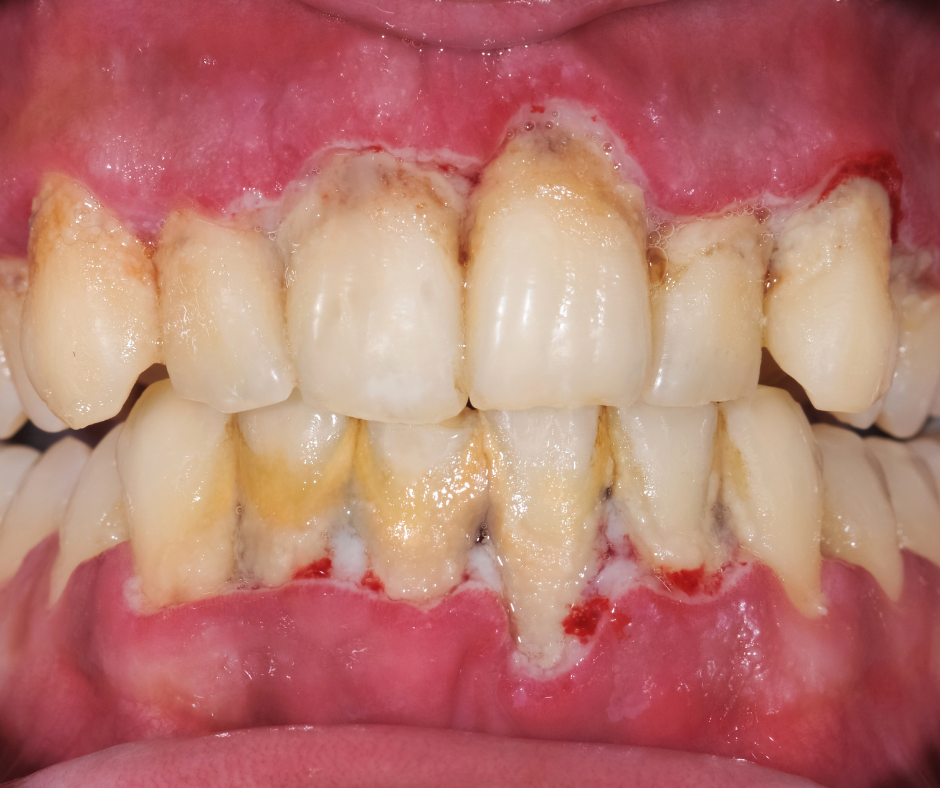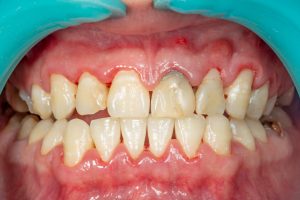Your hygienist has probably discussed periodontal disease with you, they take measurements of the gums at least every 12 months to aid in determining what stage of health your gums and bone are at. This is part of the periodontal assessment which includes but is not limited to: pocket depths, recession, bleeding, mobility, and root furcation involvement. This tool along with x rays helps us decide what treatment will be best for you.

Healthy Gums: Gum tissue is pink and firm, with no bleeding present and 2-3mm gum pockets. The teeth are firmly supported by the surrounding bone and gums.
Gingivitis: Pockets are slightly deeper, usually 4mm. Gingivitis is caused by an accumulation of bacteria. Gums become visibly swollen and usually bleed easily with brushing and flossing. At this stage the inflammation is reversible as it is limited to the gum tissue. If the bacteria are not disrupted and the plaque removed, gingivitis will progress to gum disease.
– When gingivitis is left untreated, it can advance to periodontitis, we use categories to express the severity.
Early Periodontitis: The inflammation in the gums progresses and the gums start to pull away from the teeth forming pockets that further trap plaque, bacteria and food leading to the infection in the gums. The bacterial toxins as well as the body’s own immune response will begin the process of bone loss.
Moderate Periodontitis: As the infection worsens, inflammation will become more pronounced and bleeding more severe. You may begin to experience discomfort as further damage is done to the bone and gums continue to recede.
Advanced Periodontitis: As gum disease worsens, pockets will deepen and periodontal abscesses will begin to form. These will cause pain and a foul taste. Enough bone has been lost at this point for the teeth to be significantly mobile and have a poor prognosis. Toxins from this buildup of bacterial plaque not only affect your gum tissue, but also the bone and ligaments that support your teeth.
Gum disease is the most common cause of tooth loss among adults, but can be prevented with good oral hygiene. If you’re beyond the prevention stage and have already been diagnosed with gum disease, don’t despair! If caught early and with proper therapy, gum disease can be treated and the progression significantly slowed.
The first step in treating periodontitis is a conservative, nonsurgical treatment called scaling and root planing (SRP). In this procedure your hygienist will remove the plaque and tartar off your teeth and root surfaces and also smooth any roughness on the roots in attempt to prevent bacteria from sticking again. Anesthetic is often administered for this procedure and usually they will complete only half of your mouth per session. If gum tissue health is not maintainable you might be a candidate for periodontal pocket reduction, gum grafts, or even regenerative procedures such as bone grafting.
Along with your SRP visit, your hygienist might recommend laser bacterial reduction therapy (LBR) to aid in restoring your gum health. This treatment is highly effective in eliminating difficult to treat bacteria from the mouth. Over the long-term, studies have shown that LBR in conjunction with SRP or regular cleanings, can improve the overall health of teeth, gums, and give the immune system a boost. Be sure to ask your dentist or hygienist if you might benefit from LBR at your next cleaning!
Any patient who is receiving treatment for periodontal disease must maintain a meticulous homecare routine. Our hygienists are highly trained professionals who pride themselves on their care for patients, so regardless of your state of gum health, we are your partner toward a healthier mouth! They will ensure you have the knowledge, skills, and tools to help maintain the health you are rebuilding. With most cases they will recommend more frequent visits to keep a close eye on your periodontal health.
SOURCES:
Webmd.com
https://hpsdental.com/laser-bacterial-reduction-therapy-periodontal-disease/

